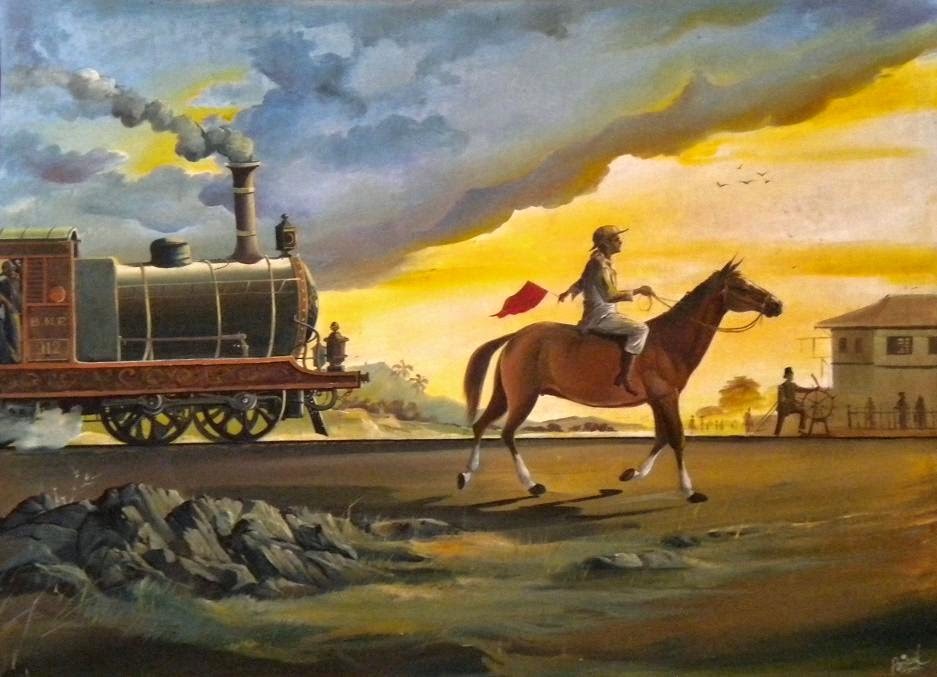BROWSING THROUGH an old issue of Model Railway Enthusiast, I was delighted with a short feature on John Austin’s railway pictures. Railway art in the UK and elsewhere is big business, although there are very few artists admittedly in the world today like John who devote themselves exclusively to painting railway pictures. John, we are told, paints overlooking the river Severn, within sight of the lovely Severn Valley Railway. Can you think of a more charming job where one’s pastime is one’s profession? There can’t possibly be.
Here in
India railway art is sadly a non-existent subject. The closest one can get to
what we may call ‘art’ is what you will find in old issues of The Illustrated London News where line
etchings and monochrome reproductions of paintings of scenes may be found from
the earliest days when the railways first came to India.
All is not dark and dismal though. I did come across some contemporary railway art, and this right here in the Narrow Gauge Railway Museum of Nagpur. These are lovely pictures. On close examination I found that the artist has avoided cramped technical detail. Instead, there is a feeling of spaciousness about his paintings where the artist seeks to convey rural settings and vast vistas of nature amidst which runs his railway brought to life so beautifully in oil-on-canvas.
All is not dark and dismal though. I did come across some contemporary railway art, and this right here in the Narrow Gauge Railway Museum of Nagpur. These are lovely pictures. On close examination I found that the artist has avoided cramped technical detail. Instead, there is a feeling of spaciousness about his paintings where the artist seeks to convey rural settings and vast vistas of nature amidst which runs his railway brought to life so beautifully in oil-on-canvas.
The
country station. And who wouldn't like to make a short distance journey to this place and spend a day at this charming station?
Travelling
by train. By the looks of it, this is most certainly a narrow gauge carriage.
The very first narrow gauge (2 ft 6 inch) train from Dabhoi to Miyagam hauled by bullocks. This type of train was know as Bullock Train, and was begun in 1860 by Gaikwar’s Baroda State Railway.
Elephants
were at one time employed for shunting goods wagons. When steam power was not available, animal power was much in demand !
Gangmen at work repairing the track
A
signalman on horseback leads the way.
More examples of railway art can be found in these lovely old stamps. This one showing a Doon Valley train is not sharp enough, else it would have been one of the loveliest pictures you would ever get to see on a postal stamp.
Ah, the National Rail Museum... These two engines seem to be on a collision course with the signal merrily showing the way clear.
150 Glorious Years of Indian Railways. I think there is an error in this picture; the earliest carriages were 4-wheelers, and it took a good many years before longish coaches needing a pair of 4-wheel bogies underneath came into use.
Headquarters building, B B & C I Railway, Churchgate was built by Victorian architect Frederick William Stevens in 1899. Now rendered in eye catching watercolour, this artwork by Ramdas Nivelkar is one among twelve greeting cards featuring heritage railway buildings on the Western Railway. The idea of having these greeting cards was the brainchild of rail heritage professional Shri A. K. Jhingron while he held the office of General Manager of the Western Railway. The whole set of greetings consisting of 12 such cards may be ordered by writing to the Public Relations Officer of Western Railway.
Ah, the National Rail Museum... These two engines seem to be on a collision course with the signal merrily showing the way clear.
150 Glorious Years of Indian Railways. I think there is an error in this picture; the earliest carriages were 4-wheelers, and it took a good many years before longish coaches needing a pair of 4-wheel bogies underneath came into use.
Headquarters building, B B & C I Railway, Churchgate was built by Victorian architect Frederick William Stevens in 1899. Now rendered in eye catching watercolour, this artwork by Ramdas Nivelkar is one among twelve greeting cards featuring heritage railway buildings on the Western Railway. The idea of having these greeting cards was the brainchild of rail heritage professional Shri A. K. Jhingron while he held the office of General Manager of the Western Railway. The whole set of greetings consisting of 12 such cards may be ordered by writing to the Public Relations Officer of Western Railway.










